SEEOcta: Business Process Reengineering (BPR) – Organisational Structure Part 2
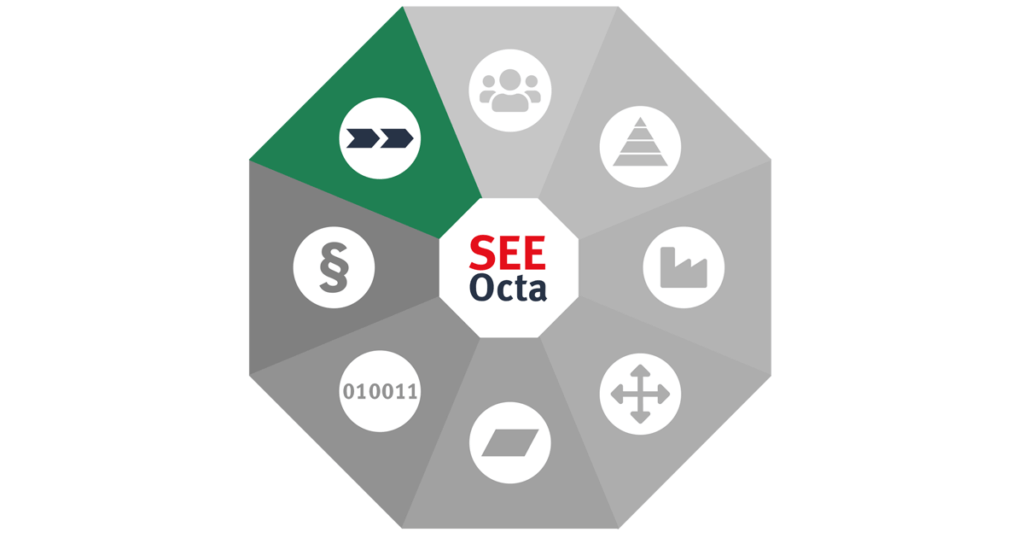
In the SEEBURGER blog post „SEEOocta-Organisational structures – Business Process Reengineering (BPR) Part 1“ we looked at business process reengineering (BPR) to restructure business processes with the goal of increasing efficiency and flexibility. BPR is an instrument to enable you to react quicker to future customer requirements and market changes. By using new communication and information media, companies are able to change their organisational structure at any time and to develop further. In this post, we will illustrate how business process reengineering can be used as a radical way to restructure your organisation.
The SEEOcta blog series highlights the eight most important perspectives for successful project management. Discover all the areas you need to consider when planning digitalisation and integration projects in your company. Armed with the ideas and knowledge in the articles, you will have a solid foundation for planning your IT project and a guide to help you ensure that no one gets left behind.
Business Process Reengineering: a brand-new start
Business Process Reengineering focuses on the following four core topics:
- Orientating the structure to important business processes
- Orientating the important business processes to customers’ needs
- Concentrating on core competencies
- Using the latest information technology (IT)
The goal is to permanently reduce costs while also speeding up business processes and increasing transparancy. As you can imagine, this is no easy undertaking that can be done in a spare few minutes. Business process reengineering involves a fundamental change in thinking. Before starting to actually restructure, it is crucial to prepare all stakeholders for a mental shift. We’re not talking about just optimising a couple of processes, but essentially a new beginning: a revolution. To this end, a company needs to throw a number of their traditional approaches over board and to consider which processes are working at the moment. By taking an approach in which you essentially start with a clean slate, required the following fundamental uestions to be considered:
- What do we do?
- Why do we do these things?
- Why do we do these things like we do?
The original proponents of Business Process Reengineering, Hammer und Champy, illustrated why you should fundamentaly question how things are run with an example from the banking sector:[1]
„When working to improve banking services, a question frequently asked is “how can we check the creditworthiness of our customers more effectively? “. This type of question is based on the widespread view that a customer’s credit rating needs to be checked, but overlooks the fact that the costs involved in checking often outweigh the losses incurred through more risky lending. BPR, however, first asks WHAT a company does before to goes on to look at HOW the business is run. In BPR, we would first ask whether such thorough checking of potential loan takers was necessary and made sense.“
Business Process Reengineering: A Framework
The phrases so often associated with business process reengineering such as ʽfundamentalʼ, ʽradicalʼ, ʽa revolutionʼ and ʽstructure follows processʼ, give you a clue how deep BPR goes. Our first post in this block looked at the importance of focussing on processes rather than functions. But let us look here at ways of transforming the company:
One framework comes from Gouillart and Kelly from the Gemini Consulting group, who spilt transformation into 4 stages, helpfully all beginning with ‘R’. Here’s how it can be used:
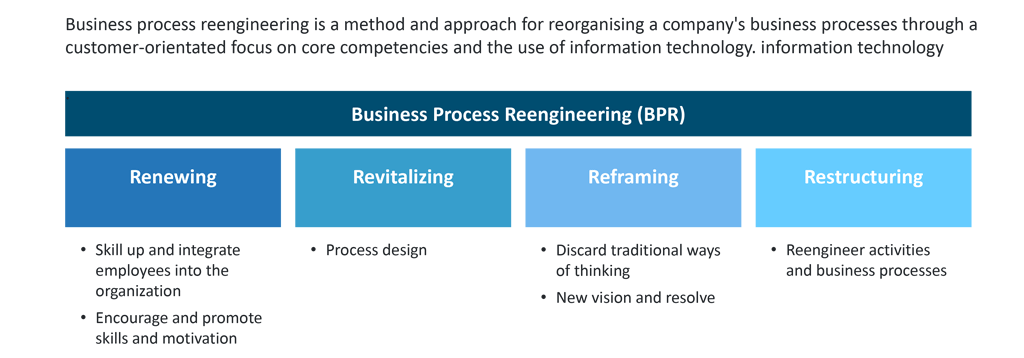
Renewal
As soon as all stakeholders throughout the organisation are on board with the upcoming transformation, the business transformation team needs to be put together. The size of this team plays a significant role in its effectiveness. The well-known former Amazon CEO Jeff Bezos framed his recommendation as the ʽtwo pizza rule‘ , saying that a team should only consist of as many people as can comfortably share two pizzas for lunch. To put this into concrete numbers, it means that teams with fewer than ten members work best. If the team is kept to this manageable number, business can be conducted efficiently and effectively. Employees are schooled in such a way that they can identify breakthrough opportunities with their newly acquired knowledge and can design new steps or processes to increase profits and competitiveness.
Revitalization
In this phase, BPR looks at business processes. The existing processes are examined and recorded to define what needs reorganising. At the forefront is the value chain, which is optimised in the reframing stage.
Reframing
This is where employees are encouraged to realign their old way of thinking, and the company’s philosophy as a whole is reorientated. The current ways of thinking are examined, discarded, or at least modified. Here, management and employees have the opportunity to introduce new visions and suggestions. BPR fundamentally changes the content of employees‘ work. Their goal is no longer to work through tasks given to them, rather to be responsible for fulfilling their customers’ wishes. On the one hand, this is a bonus, on the other hand, it increases pressure. Not necessarily an abstract pressure to perform, rather pressure to increase their own skills.
Old perspectives give way to new (Hammer, Champy, P. 103f.)[2]:
| Old rules | New rules |
|
|
The goal in changing old thought patterns is to build resolve. In this BPR stage, new methods and attitudes are being established in the company and the structure business processes should take are being defined.
Restructuring
Now, the desired structures need to be implemented. The following image is a summary of eight basic variations of process optimisation in practice.[3] However, it is vital to consider your own company’s exact circumstances before trying to optimise. It’s particularly important to concentrate on the bottlenecks, as these are relevant for shortening the time it takes to complete a process. The optimisation approaches illustrated below are a good overview of the basic possibilities, are however not exhaustive. Other possibilities such as simplifying and unifyingprocesses or making them cheaper should also be considered.
| Concept | Sketching | Explanation |
| 1. Omitting | 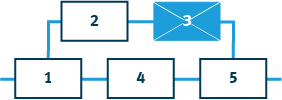 |
|
| 2. Outsource | 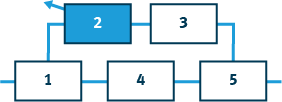 |
|
| 3. Summarize | 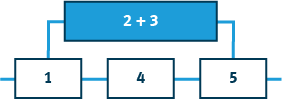 |
|
| 4. Parallelize | 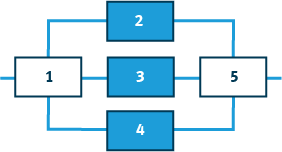 |
|
| 5. Relocate |  |
|
| 6. Accelerate |  |
|
| 7. No loops |  |
|
| 8. Complete |  |
|
For all process it is important to constantly monitor your goals and to adapt as necessary.
The hierarchy of business process reengineering
In order to successfully implement these business process reengineering steps, somebody needs to be in charge of seeing these processes through and of persuading staff that these fundamental changes are necessary. Here, a charismatic leader-type needs to be given the task of putting together a team of top managers to each take charge of a process and be strongly supported in this.
The people responsible for each process form a reengineering team. They are also responsible for making the resources needed available and ensure, that their team can work as smoothly as possible.
In the Reengineering team, the individual members are now responsible for implementing the processes. In order to ensure that as many perspectives as possible are considered, teams are made up of both internal staff and external participants.
A particular role is played by a Reengineering Tsar. This person answers directly to the leader and coordinates all the projects in the company. A particularly important function this person has is to provide the infrastructure, such as IT. Ideally, this person works closely with the key users chosen to help launch an IT project, whose qualities and tasks of a key user we have looked at in detail in dedicated blog posts, including liasing between project teams.
Advantages and disadvantages of business process reengineering
To what extent business process reengineering is suitable for an organisation is an individual decision. Essentially, Business Process Reengineering carries a number of advantages:
- Customer orientation
- Gaining a holistic view of processes
- Reducing time spent and costs while simultaneously improving quality
- Reducing problems at interfaces as the company is moving from a function-based to a process-based structure
- Gaining a holistic view of the company along the value chain, including the emotional attitudes of the employees
- Using new information and communication technologies
Alongside these many advantages, carrying out a business process reengineering approach is also associated with risk:
- Structures which have been working well may need to be broken up
- BPR often leads to job losses
- It can lead to resistance in the workforce
- BPR is associated with a high time and financial investment
In order to work against any resistance among staff, senior management in particular needs to prepare the staff for the process optimisation by demonstrating the importance of this for the future of the company and, by extension, for the future of the employees. Management needs to try and minimise resistance by thoroughly informing, communicating and motivating, as well as rewarding performance. When implementing business process reengineering measures, it is critical that these are supported by a good change management strategy
Conclusion
Companies who are active in a global market and which are being confronted with rapid developments in technology have to be able to adapt to rapidly chaning market conditions. In order to remain competitive, they need to develop new products, business models and business processes at ever shorter intervals. Customer orientation and focus take top priority and companies which change their function-based structure for a more customer-orientated design have a great chance of success. Companies with a traditional, functional structure can generally only get so far in today’s global, agile markets. By contrast, a process-orientated organisational structure is a viable response to the new challenges and enable digital transformation to be successfully implemented.
Using BPR to introduce a process-orientated organisation requires a paradigm shift. This organisational change needs to be accompanied by a well considered communication plan and change management strategy. Business process reengineering is a radical method to improve processes and thought patterns in an organisation. It is a process which never ends, as newly conceived business processes may need their own redisign in years to come.
[1] Vgl. Hammer, M., Champy, J. (1994), S. 49.
[2] Business Reengineering: Die Radikalkur für das Unternehmen, Michael Hammer und James Champy, 2003, S. 103
[3] Christian Langmann, Daniel Turi; Buchtitel: „Einführung von RPA im Controlling & Rechnungswesen“; Veröffentlicht 20.Februar 2020.
Thank you for your message
We appreciate your interest in SEEBURGER
Get in contact with us:
Please enter details about your project in the message section so we can direct your inquiry to the right consultant.
Written by: Rolf Holicki
Rolf Holicki, Director BU E-Invoicing, SAP&Web Process, is responsible for the SAP/WEB applications and digitization expert. He has more than 25 years of experience in e-invoicing, SAP, Workflow and business process automation. Rolf Holicki has been with SEEBURGER since 2005.



